Click image for BBB rating
See our Privacy Policy
cool="cool" width="785" height="7791" border="0" cellpadding="0" cellspacing="0" gridx="16" showgridx="showgridx" usegridx="usegridx" gridy="16" showgridy="showgridy" usegridy="usegridy" bgcolor="#99ccff">
|
|
|
 |
|
|
|
|
|
|
Welcome to Spaightwood Galleries, Inc.
120 Main Street, Upton MA 01568-6193
You can follow us on Facebook and Twitter!
We blog regularly on Facebook and announce special events and special sales on both sites.
Georges Rouault (French, 1871-1958): Miserere I
|
|
|
|
Georges Rouault, although not one of the original group of Fauves, is associated with them because of his use of colors to affect the way we see his images. He is also widely considered the most important Christian religious artist of the twentieth century. Rouault, born during the German bombardment of Paris in 1871, regarded World War I as an indication of what people could do to each other if left on their own: the title of one of the prints in the Miserere, his great series of mixed-media intaglio prints, is taken from Plautus's Asinaria, concerning the Roman Civil Wars, "Man is a Wolf to Man." In his paintings as well as in his prints, Rouault shows us that though "We think ourselves Kings," we are more accurately seen as circus clowns, each wearing our own mask to disguise our true nature ("Are we not all convicts?" asks the title of one of The Miserere) from ourselves. For Rouault, what saves us from ourselves, if anything can, is Christ and the Virgin Mary, both depicted throughout many of Rouault's works. In an essay on Rouault's graphic works in the inaugural issue of Print Collector (Fall-Winter 1972, p. 28), F. Agustoni comments on the Miserere: "Miserere et Guerre is the largest set engraved by Georges Rouault, and it includes 58 large aquatints done between 1916 and 1927 and published in 1948. The edition consist of 425 copies plus another 25 not in circulation. Other than being the most abundant as regards the number of plates engraved, the Miserere is also probably the most significant and sensitive series in the artist's graphic work. Conceived in the years in which Europe was hardest hit by the war, the set was inspired by the suffering of human beings, which often can be without any reason for those who have to endure it, which makes it even more distressing. But this reflection Rouault turns into a prayer, a prayer that, if not always founded in great serenity, is always concluded in a deep-seated resignation for all things in Christ. . . . If in the beginning the seed of rebellion often forms it is transformed every time through a laborious moral and artistic process into a consciousness of overall participation as much in guilt as in redemption. And out of this certainty hate cannot form towards anyone, but rather solidarity for all beings, to the extreme conviction that for the righteous death is not death, but a rebirth after a long period amidst earthly sorrow. "Celui qui croit en moi, fût-il mort, vivra" (Anyone who believes in me, though he were dead, shall live [John 11:25], plate 28). The titles are Rouault's.
In Rouault, his study of Rouault's works, Fabrice Hergott argues that Miserere is to be considered the artist's masterpiece, the work to which he devoted the most time and effort and which undoubtedly synthesizes his creation as a whole. The nuances of black and gray, which the camera is incapable of capturing, are so subtle and harmonious that they are the profound manifestation of his mastery over matter and color. It is the visual equivalent of horror, an inner witness to the effects of war in which Baudelaire's crepuscular atmosphere and the tristess majestueuse that Racine sought in his preface to Berenice come together. The scenes succeed each other in silence as in a very slow motion film in which each frame is the result of years of work. Yet while the motifs are often somber, they are never sinister. The work is a reverie made up of the most precise memories and visions that refer to the most important stages in man's destiny. Kings, criminals, mothers, 'ladies of noble birth,' families of beggars, prostitutes, clowns, and corpses gather round the Virgin and Child in the baptism of Jesus, his crucifixion and his resurrection" (Barcelona: Ediciones Poligrafa, 1991, p. 23; English translation by Richard Rees).
In addition to being considered by many to be Rouault's single greatest work, the Miserere has come to be regarded as one of the most significant 20th-Century works dealing with the crises of the early twentieth century: the introduction of weapons of mass destruction during the first world war (machine guns, poison gas, strafing and bombing), political instability (the Russian Revolution, the dissolution of the German monarchy and the Austrian Empire, the rise of the right wing in Germany), social turmoil (the rise of fascism in Italy, communism in Russia and the fear of the "spectre" of Bolshevism spreading across Europe and America after the end of World War I), and spiritual upheaval ( the challenge of evolutionary theory and psychoanalysis to traditional Christianity in Europe and America). When Rouault finally retrieved the unpublished sheets of his mixed media pieces of the Miserere (printed during the late 1920s and stored by Vollard until his death in 1939), and published them in 1948 following what must have been the greatest slaughter in the history of the Western world, their impact was incredible: they were featured in whole or in large part at major retrospectives at the Museum of Modern Art in NY, the Musée National d'Art Moderne (in Paris), the Musée de Quebec, the Musée d'art Contemporain de Montreal (among many others) and complete sets were acquired by many Catholic Universities (such as St. Louis University and Marquette University in Milwaukee), where they were often exhibited during Lent as an aid to reflection and spiritual self-analysis in preparation for the events of the Passion, Crucifixion, and Resurrection of Christ. Complete sets of the Miserere are owned by, among others, the Art Institute of Chicago (2 copies), The Brooklyn Museum of Art, the Boston Public Library, the Fogg Art Museum at Harvard, the Grunwald Center for the Graphic Arts (UCLA), the Metropolitan Museum of Art, MoMA, the National Gallery of Art, and the Philadelphia Museum of Art. They were also included in their entirety in the exhibition that the Museum of Modern Art put on in 1977, Ambroise Vollard Editeur. As the catalogue to the Rouault Retrospective held at the Musée de Quebec and the Musée d'art Contemporain de Montreal put it, they are the "the center and the summit of the art of Rouault" (p. 123) and rank with the Small Passion of Dürer, the Hundred Guilder Piece [the large Crucifixion] and the Three Crosses of Rembrandt, and the Caprichos of Goya as "monuments of printmaking" (p. 124). As James Thrall Soby pointed out in his 1947 introduction to a Rouault Retrospective at MoMA, the two great antagonists of the Miserere are Christ, "recumbent and mourned in In the press the grape was trampled, youthful and martyred in St. Veronica's veil [the concluding image in the series], on the cross unheeded in Love ye one another, which recalls Grünevald in its almost Germanic realism" and "Christ's wartime antagonist . . . Death, implacably waiting in This will be the last, Little Father and cruelly half-victorious in The blind will long be led by the halt" (p. 22). It is perhaps the ultimate tragedy of life on earth that in the aftermath of the failures of the League of Nations after World War I and the United Nations after World War II to make sure that the last war would be "the last," it will always be necessary for artists like Rouault to come forward and show new audiences that "Man is a beast to man" (plate 37, title taken from Plautus, Asinaria, II, 4, 88), that life is full of tears ("Sunt lacrimae rerum" (plate 27, title taken from Virgil's Aeneid) and that our sole remedy is ultimately that of Psalm 130, the De profundis, the cry of humanity out of the depth of its despair (plate 47).
The standard reference work on Rouault's prints is the two-volume set by François Chapon and Isabelle Rouault, Rouault Oeuvre Gravé (Monte Carlo: Editions André Sauret, 1978). There are very good reproductions of all of the plates in Miserere, published with a preface by Rouault and an introduction by Sir Anthony Blunt by the Boston Book and Art Shop with The Trianon Press in 1963.
Selected Bibliography: Paolo Bellini, Georges Rouault: Incisore e litografo (Triennale Europea Dell'Incisione di Grado: Edizioni Della Laguna. 1988); Centre Georges Pompidou, Georges Rouault: 1ere Periode, 1903-1920 (Paris: Editions Du Centre Pompidou, 1992); François Chapon, The Illustrated Books of Rouault (Monte Carlo: Editions Andre Sauret & Editions Michele Trinckvel, 1992); Pierre Courthion, Georges Rouault with a catalogue of works prepared with the collaboration of Isabelle Rouault (NY: Abrams, 1961); Bernard Dorival, Georges Rouault 1871-1958 (London: The Arts Council of Great Britain, 1974); Bernard Dorival, Le Miserere de Georges Rouault (Montreal: Musee De L'Oratoire Sainte-Joseph, 1979); Bernard Dorival & Isabelle Rouault, Rouault. L'oeuvre peint. 2 vols. (Monte-Carlo: André Sauret, 1988); William A. Dyrness, Rouault: A Vision of Suffering and Salvation (Michigan: William B. Eerdmans, 1971); Holly Flora & Soo Yun Kang, Georges Rouault's Miserere et Guerre: This Anguished WOrld of Shadows (NY: MOBIA: Museum of Biblicl Art, 2006); Frank and Dorothy Getlein, Georges Rouault's Miserere (Milwaukee, WI: The Bruce Publishing Co., 1964), Fabrice Hergott, Rouault (Barcelona: Ediciones Poligrafa, 1991); Fabrice Hergott, Georges Rouault: "Forme, couleur, harmonie" (Strasbourg: Musees de Strasbourg, 2006); Fabrice Hergott and Sarah Whitfield, Georges Rouault: The Early Years 1903-1920 (London: Royal Academy of Arts / Lund Humphries, London, 1993); Edward Alden Jewell, Georges Rouault (Paris: Hyperion, 1947); James Thrall Soby, Georges Rouault Paintings and Prints (NY: The Museum of Modern Art, 1947); Lionello Venturi, Rouault (Geneva: Skira, 1959); Monroe Wheeler, The Prints of Georges Rouault (NY: Museum of Modern Art, 1938); Alan Wofsy, Georges Rouault. The graphic work (San Francisco: A. Wofsy Fine Arts, 1976); XXe Siècle. Numéro spéciale: Hommage á Georges Rouault, ed. G. di San Lazzaro (Paris: XXe Siecle, 1971).
Please keep scrolling. After long text entries, there will be a gap before the images appear.
|
|
|
|
 |
|
|
Plate 1: Miserere (C & R 54e). Original aquatint, drypoint, burnisher, and roulette, 1923. 450 impressions signed in the plate (there are no pencil-signed proofs) for Rouault's masterpiece of the same title, one of the greatest print cycles of all time. Rouault choose this print of Christ as the suffering servant to introduce the series, begun during the years after the horrors of the first world war; his full title comes from the opening of Psalm 51 "Have mercy upon me, O God, according to thy loving-kindness." Image size: 575x423mm. Price: Please call or email for current pricing information.
|
|
|
|
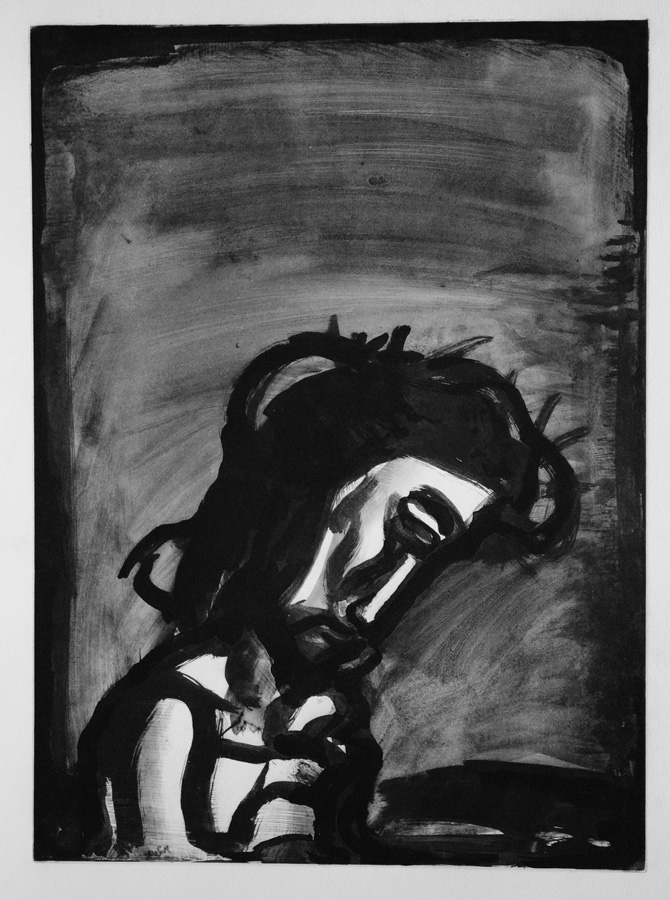 |
|
Miserere Plate 2: Jésus honni / Jesus reviled (C & R 55d). Original aquatint, roulettte, drypoint, burnisher, and roulette, 1922. 450 impressions signed in the plate (there are no pencil-signed proofs) for Rouault's masterpiece of the same title, one of the greatest print cycles of all time. Rouault again repeats his theme of Christ as the suffering servant, rejected by those whom he came to redeem. Image size: 575x420mm. Price: Please call or email for current pricing information.
|
|
|
|
 |
|
Miserere Plate 4: Se réfugie en ton coeur, va-nu-pieds de malheur / Take refuge in your heart, poor vagabond (C & R 57g). Original aquatint, drypoint, burnisher, and roulette, 1922. 450 impressions signed in the plate (there are no pencil-signed proofs) for Rouault's masterpiece of the same title, one of the greatest print cycles of all time. An adult "comforts" a child facing a life as a displaced person that offers no comforts by reminding him that there my be comfort to be found within his own heart. Image size: 485x370mm. Price: Please call or email for current pricing information.
|
|
|
|
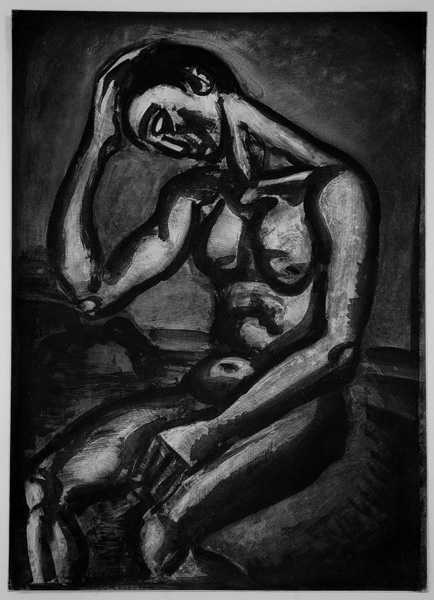 |
|
Miserere Plate 5: Solitaire, en cette vie d'embuches et de malices (C&R 58e). Original aquatint, drypoint, burnisher, roulette, 1922. 450 impressions for the Miserere. The print was just washed and deacidified and except for small margins is a dark, rich impression in very good condition. Signed and dated 1922 bottom left. There are no pencil-signed proofs. Image size: 579x417mm. Price: Please call or email for current pricing information.
|
|
|
|
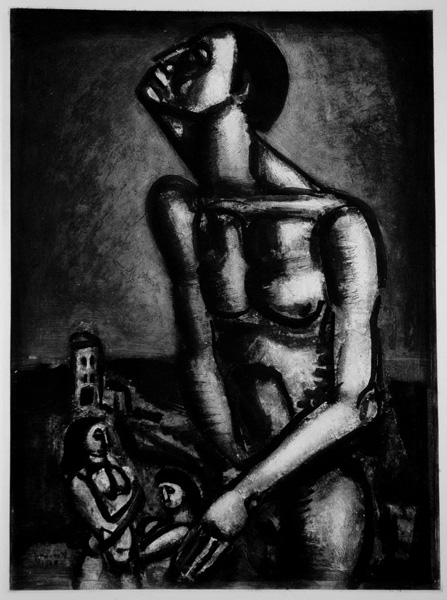 |
|
Miserere Plate 6: Ne sommes-nous pas forçats? / Are we not slaves? (C&R 59d) Original aquatint, drypoint, burnisher, roulette, 1926. 450 impressions for the Miserere. Ours is a beautiful impression in excellent condition. Signed and dated 1926 bottom left. There are no pencil-signed proofs. One of the greatest prints of the 20th-Century. Rouault and Chagall are generally acclaimed as the two most important religious artists of the 20th century. Image size: 590x435mm. Price: SOLD.
|
|
|
|
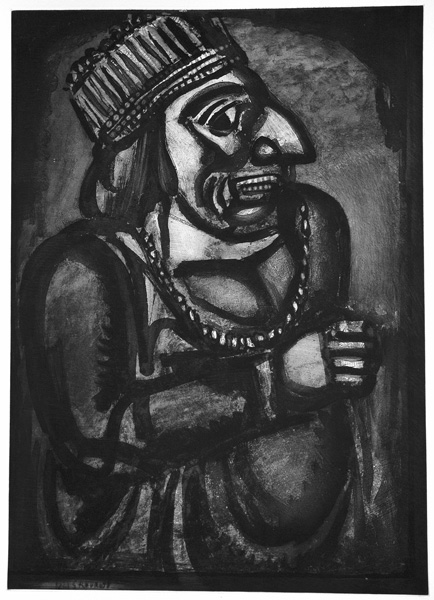 |
|
Miserere Plate 7: Nous croyons rois / We believe ourselves kings (C&R 60e) Original aquatint, sugar aquatint, drypoint, scraper, burnisher, roulette, 1923. 450 impressions for the Miserere. The print was just washed and deacidified. It is a dark, rich impression in very good condition. Signed and dated 1923 bottom left. There are no pencil-signed proofs. One of the greatest prints of the 20th-century, showing the limits of our ability to convince ourselves that we as great as we would like to think that we are. Illustrated Rouault Retrospective Exhibition, 1953 (Museum of Modern Art, NY) and Musée National d'Art Moderne, 1971, among others. Image size: 590x420mm. Price: SOLD.
|
|
|
|
|
|
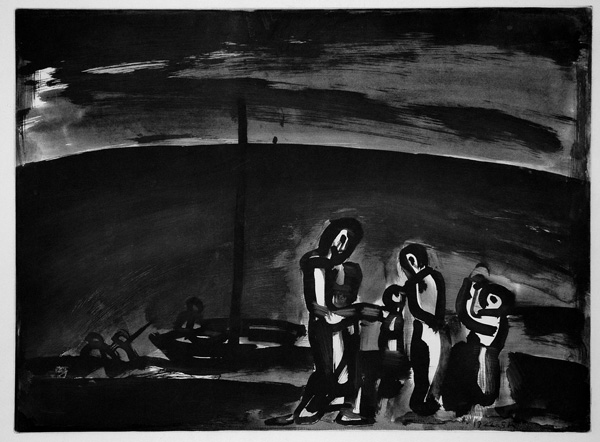 |
|
|
Miserere Plate 9: Il arrive parfois que la route soit belle / Sometimes the way is beautiful (C&R. 62d) Original aquatint, drypoint, burnisher, roulette, 1922. 450 impressions for the Miserere, Rouault's masterpiece and one of the most important series of the twentieth century. Here, a group of people suddenly find themselves in the company of Jesus by a body of water perhaps not unlike the Sea of Galilee on a shore not unlike Capernaum. A superb, dark, rich impression in very good condition with full margins. Signed and dated 1922 bottom right. There are no pencil-signed proofs. Image size: 575x505mm. Price: Please call or email for current pricing information.
|
|
|
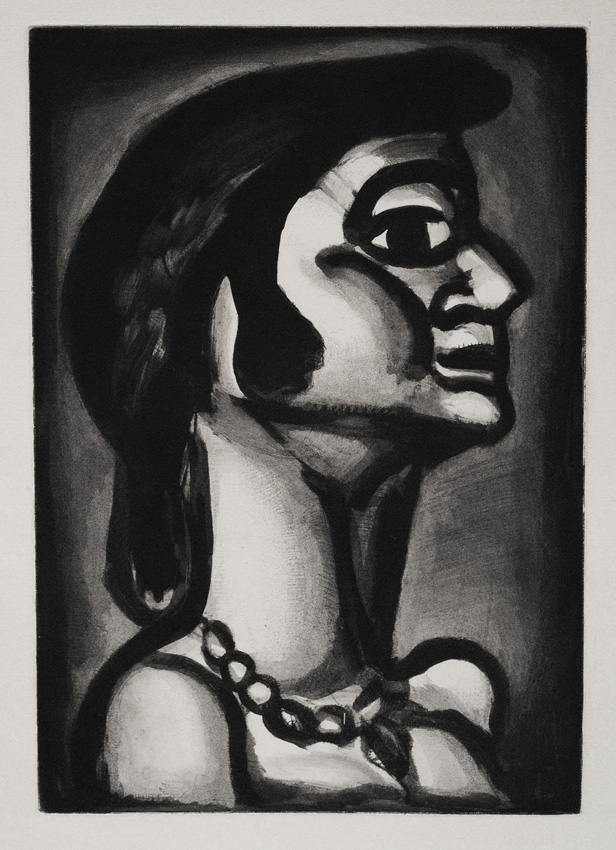 |
|
|
|
Miserere Plate 15: En bouche qui fut fraîche, goût de fiel / In the mouth that was once fresh, the taste of bitterness (C&R 68) Original aquatint, drypoint, burnisher, roulette, 1922. 450 impressions for the Miserere. Ours is a trial proof of an intermediate state before the date and signature were added, before the additions below the chin on the right, the spitbite additions lower right and below the chin, but with the drypoint on the neck, upper lip, and jaw. Except for the work lower right, it almost seems that it might represent some additional work after the final state. Image size: 505x350mm. Price: Please call or email for current pricing information.
|
|
|
|
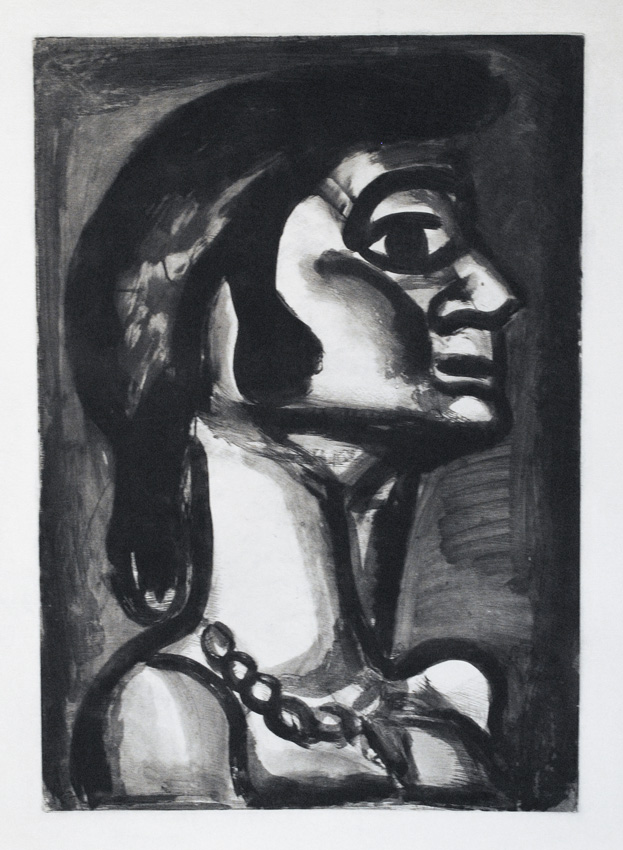 |
|
Miserere Plate 15: En bouche qui fut fraîche, goût de fiel / In the mouth that was once fresh, the taste of bitterness (C&R 68d) Original aquatint, drypoint, burnisher, roulette, 1922. 450 impressions for the Miserere. Ours is a bnrilliant impression of the final state, in which the almost smile of the piece above is gone, replaced by grim determination and despair, the shadow on the cheek is much darker, and body seeems almost more drawn in upon itself. Flora and Kang cite Lamentations 3:18-23 as a possible verbal equivalent: "my soul is bereft of peace; I have forgotten what happiness is; so I say, ‘Gone is my glory, and all that I had hoped for from the Lord.’ The thought of my affliction and my homelessness is wormwood and gall! My soul continually thinks of it and is bowed down within me." Image size: 505x350mm. Price: Please call or email for current pricing information.
|
|
|
|
|
|
|
Spaightwood Galleries, Inc.
To purchase, call us at 1-800-809-3343 (1-508-529-2511 in Upton MA & vicinity) or send an email to spaightwood@gmail.com.
We accept AmericanExpress, DiscoverCard, MasterCard, and Visa.
We also accept wire transfers and paypal.
For directions and visiting information, please call. We are, of course, always available over the web and by telephone (see above for contact information). Click the following for links to past shows and artists. For a visual tour of the gallery, please click here. For information about Andy Weiner and Sonja Hansard-Weiner, please click here. For a list of special offers currently available, see Specials.
Go back to the top of this page.
Visiting hours: Saturday 10:00 am to 5:00 pm and Sunday noon to 6:00 pm and other times by arrangement.
Please call to confirm your visit. Browsers and guests are welcome.
|
|
|
|
|
|
|
|
|
|
|
|
|
|
|
|
|
|
|
|
|
|
|
|
|
|
|
|
|
|
|
|
|
|








